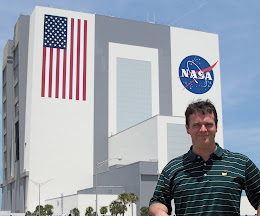Nearly six hours later, the crew of three successfully docked to the Russian Rasvet module on the Earth facing side of the space station at 5:54 p.m. EDT -- seven minutes earlier than planned.
NASA astronaut Randy J. Bresnik, Russian Soyuz commander Sergey Ryazanskiy, and Europe's Paolo Nespoli, all three space veterans, will be busy with a multitude of science experiments; the arrival and undocking of several unmanned cargo crafts; and spacewalking as they prepare the orbital outpost for new hardware.
Launched from the historic launch site at Baikonur Cosmodrome in Kazakhstan at 11:41 a.m. EDT (9:41 p.m. local), today's lift-off occurred from the same pad Russia's Sputnik 1 launched from sixty years ago this October. That successful satellite launch in 1957 heralded the dawn of the space age.
As the Soyuz soared skyward into the darkening skies of sunset, a 400-foot golden flame pushed the rocket higher as it traveled eastward. Nearly nine minutes later, a strong jolt was felt by the crew as their Soyuz spacecraft separated from the rocket's third stage upon reaching orbit 125 miles above.
As the Soyuz soared skyward into the darkening skies of sunset, a 400-foot golden flame pushed the rocket higher as it traveled eastward. Nearly nine minutes later, a strong jolt was felt by the crew as their Soyuz spacecraft separated from the rocket's third stage upon reaching orbit 125 miles above.




